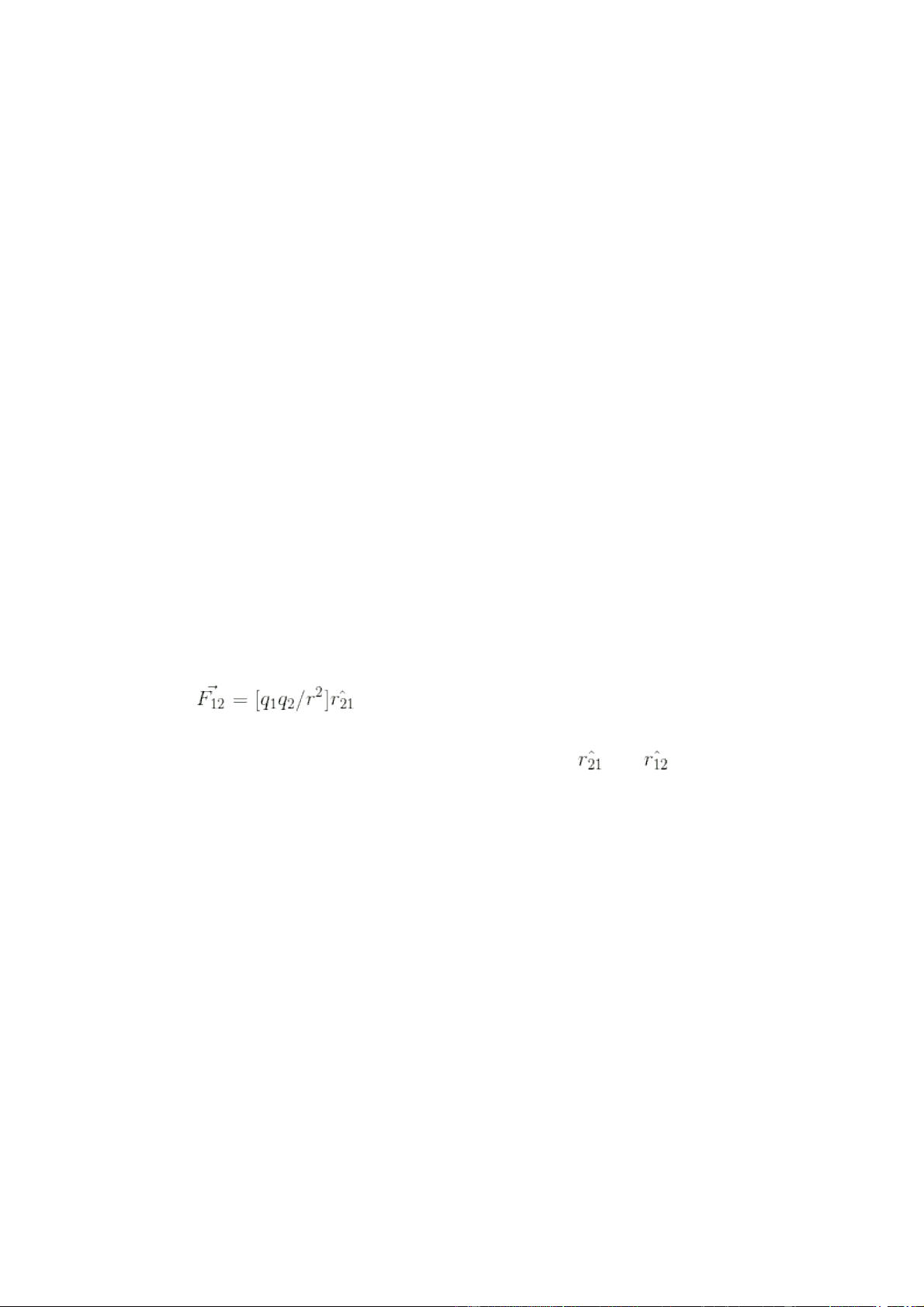
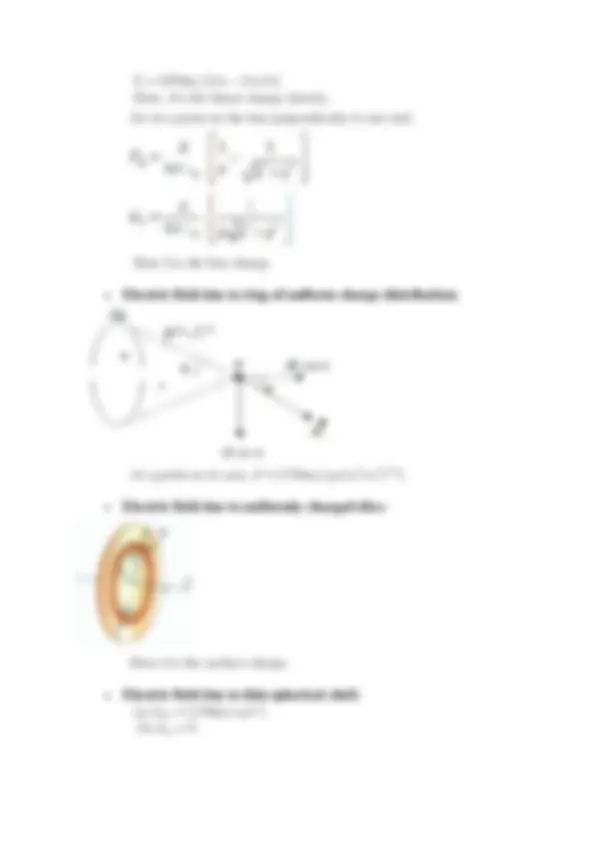
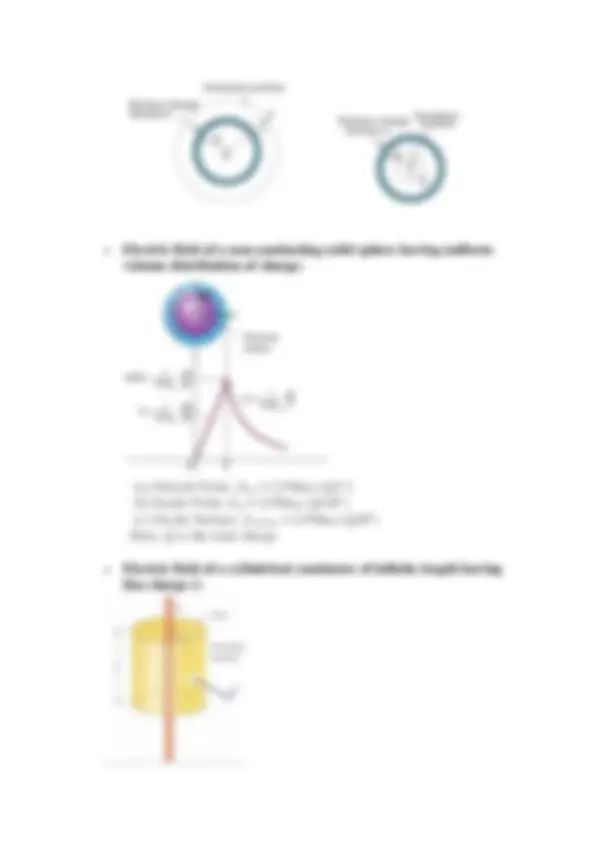
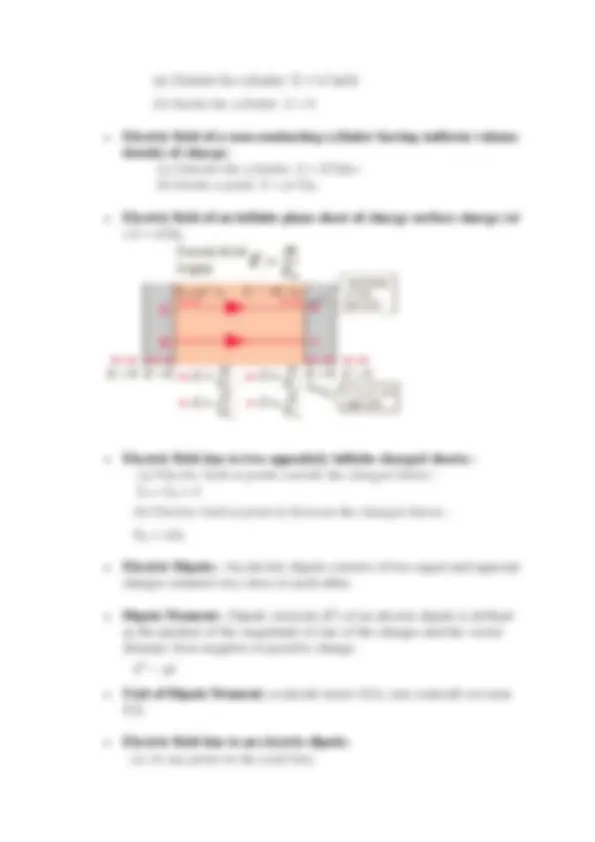
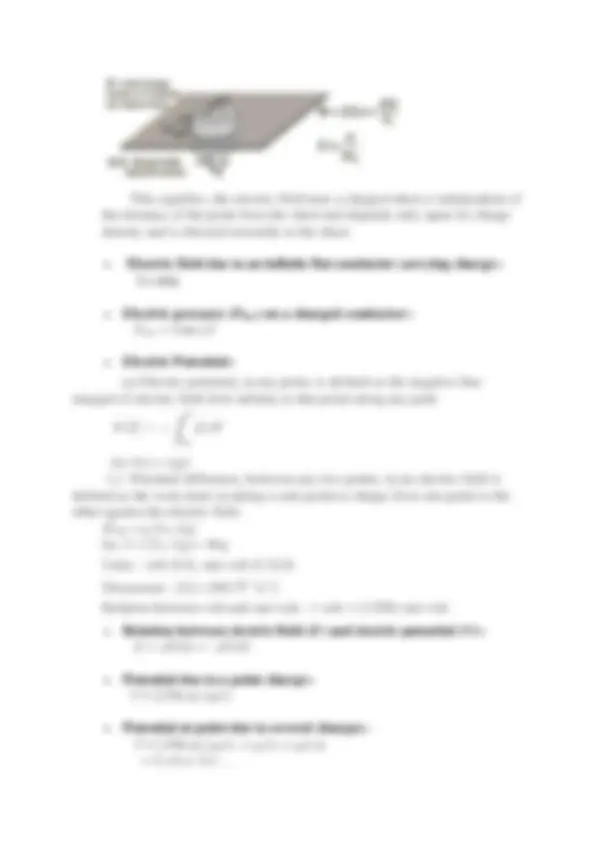
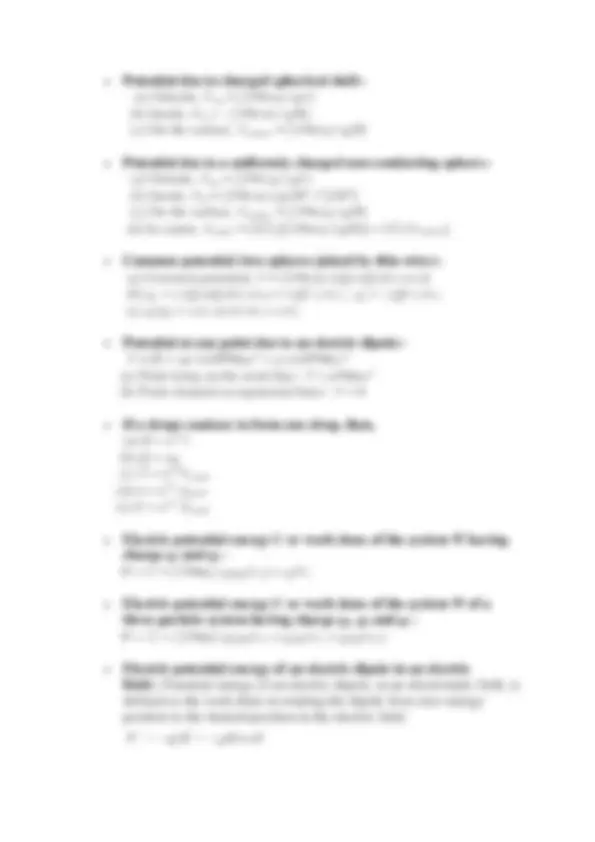
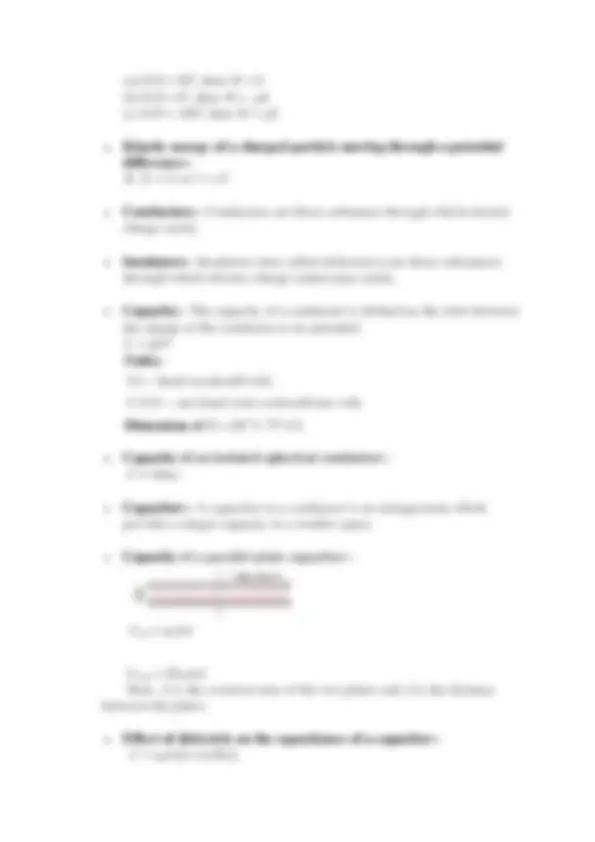
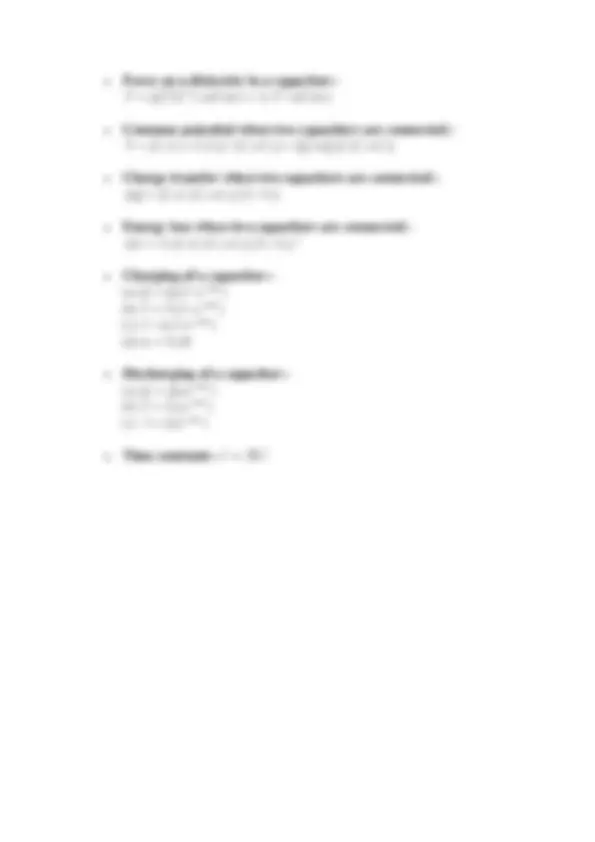


Study with the several resources on Docsity

Earn points by helping other students or get them with a premium plan


Prepare for your exams
Study with the several resources on Docsity

Earn points to download
Earn points by helping other students or get them with a premium plan
Community
Ask the community for help and clear up your study doubts
Discover the best universities in your country according to Docsity users
Free resources
Download our free guides on studying techniques, anxiety management strategies, and thesis advice from Docsity tutors
Short Notes of Electrostatics contains important points and formulae's of the chapter for last minute revision to students before exams.
Typology: Cheat Sheet
1 / 13

This page cannot be seen from the preview
Don't miss anything!








Electrostatics: It is a branch of physics that deals with the phenomena and properties of stationary or slow-moving electric charges with no acceleration. Coulomb’s Law: It states that the electro-static force of attraction or repulsion between two charged bodies is directly proportional to the product of their charges and varies inversely as the square of the distance between the two bodies. F = K q 1 q 2 / r^2 Here, K = 1/4π ε 0 = 9×10^9 Nm^2 C -^2 (in free space) Relative Permittivity ( ε r): The relative permittivity ( ε r) of a medium is defined as the ratio between its permittivity of the medium ( ε ) and the permittivity ( ε 0 ) of the free space. ε r = ε / ε 0 Coulomb force in vector form: The force on charge q 1 due to q 2 is, If q 1 q 2 >0, R.H.S is positive. If q 1 q 2 <0, a negative sign from q 1 q 2 will change and. The relation will again be true, since, in that case have same directions. Unit of Charge: C.G.S, q = ±1 stat-coulomb S.I, q = ±1 Coulomb Relation between coulomb and stat-coulomb: 1 coulomb = 3×10^9 stat-coulomb 1 coulomb =(1/10) ab-coulomb (e.m.u of charge) Dielectric constant: The dielectric constant ( ε r) of a medium can be defined as the ratio of the force between two charges separated by some distance apart in free space to the force between the same two charges separated by the same distance apart in that medium. So, ε r = ε / ε 0 = F 1 / F 2
Here, F 1 and F 2 are the magnitudes of the force between them in free space and in a medium respectively. Charges: Line charge, λ = q / L Surface charge, σ = q / A Volume charge, ρ = q / V Electric field ( ): The strength of an electric field is measured by the force experienced by a unit positive charge placed at that point. The direction of field is given by the direction of motion of a unit positive charge if it were free to move. Unit of Electric field: E = [Newton/Coulomb] or [Joule/(Coulomb) (meter)] Electric lines of force: An electric line of force is defined as the path , straight or curved , along which a unit positive charge is urged to move when free to do so in an electric field. The direction of motion of unit positive charge gives the direction of line of force. Properties: (a) The lines of force are directed away from a positively charged conductor and are directed towards a negatively charged conductor. (b) A line of force starts from a positive charge and ends on a negative charge. This signifies line of force starts from higher potential and ends on lower potential. Electric field intensity due to a point charge: E = (1/4π ε 0 ) ( q / r^2 ) Electric field Intensity due to a linear distribution of charge: (a) At point on its axis.
Electric field of a non-conducting solid sphere having uniform volume distribution of charge: (a) Outside Point: E out = (1/4π ε 0 ) ( Q / r^2 ) (b) Inside Point: E in = (1/4π ε 0 ) ( Qr / R^3 ) (c) On the Surface: E surface = (1/4π ε 0 ) ( Q / R^2 ) Here, Q is the total charge Electric field of a cylindrical conductor of infinite length having line charge λ :
(a) Outside the cylinder: E = λ/2πε0r (b) Inside the cylinder: E = 0 Electric field of a non-conducting cylinder having uniform volume density of charge: (a) Outside the cylinder: E = λ /2π ε 0 r (b) Inside a point: E = ρr /2 ε 0 Electric field of an infinite plane sheet of charge surface charge ( σ ) : E = σ /2 ε 0 Electric field due to two oppositely infinite charged sheets:- (a) Electric field at points outside the charged sheets:- EP = E R = 0 (b) Electric field at point in between the charged sheets:- EQ = σ / ε 0 Electric Dipole:- An electric dipole consists of two equal and opposite charges situated very close to each other. Dipole Moment:- Dipole moment ( ) of an electric dipole is defined as the product of the magnitude of one of the charges and the vector distance from negative to positive charge. Unit of Dipole Moment: coulomb meter (S.I), stat coulomb cm (non S.I) Electric field due to an electric dipole: (a) At any point on the axial line:
Electric Flux:- Electric flux_?_ E for a surface placed in an electric field is the sum of dot product of and for all the elementary areas constituting the surface. Gauss Theorem:- It states that, for any distribution of charges, the total electric flux linked with a closed surface is 1/ ε 0 times the total charge with in the surface. Electric field ( E ) of an infinite rod at a distance ( r ) from the line having linear charge density ( λ ):- E = λ /2π ε 0 r The direction of electric field E is radially outward for a line of positive charge. Electric field of a spherically symmetric distribution of charge of Radius R :- (a) Point at outside ( r > R ):- E = (1/4π ε 0 ) ( q / r^2 ), Here q is the total charge. (b) Point at inside ( r < R ):- E = (1/4π ε 0 ) ( qr / R^3 ), Here q is the total charge. Electric field due to an infinite non-conducting flat sheet having charge σ:- E = σ /2 ε 0
This signifies, the electric field near a charged sheet is independent of the distance of the point from the sheet and depends only upon its charge density and is directed normally to the sheet. Electric field due to an infinite flat conductor carrying charge:- E = σ / ε 0 Electric pressure ( P elec) on a charged conductor:- P elec = (½ ε 0 ) σ^2 Electric Potential:- (a) Electric potential, at any point, is defined as the negative line integral of electric field from infinity to that point along any path. (b) V ( r ) = kq / r (c) Potential difference, between any two points, in an electric field is defined as the work done in taking a unit positive charge from one point to the other against the electric field. W AB = q [ V A- V B] So, V = [ V A- V B] = W / q Units:- volt (S.I), stat-volt (C.G.S) Dimension:- [ V ] = [ML^2 T-^3 A-^1 ] Relation between volt and stat-volt:- 1 volt = (1/300) stat-volt Relation between electric field ( E ) and electric potential ( V ):- E = - dV / dx = -- dV / dr Potential due to a point charge:- V = (1/4π ε 0 ) ( q / r ) Potential at point due to several charges:- V = (1/4π ε 0 ) [ q 1 / r 1 + q 2 / r 2 + q 3 / r 3 ] = V 1 + V 2 + V 2 +….
(a) If θ = 90º, then W = 0 (b) If θ = 0º, then W = - pE (c) If θ = 180º, then W = pE Kinetic energy of a charged particle moving through a potential difference:- K. E = ½ mv^2 = eV Conductors:- Conductors are those substance through which electric charge easily. Insulators:- Insulators (also called dielectrics) are those substances through which electric charge cannot pass easily. Capacity: - The capacity of a conductor is defined as the ratio between the charge of the conductor to its potential C = Q / V Units:- S.I – farad (coulomb/volt) C.G.S – stat farad (stat-coulomb/stat-volt) Dimension of C :- [M-^1 L-^2 T^4 A^2 ] Capacity of an isolated spherical conductor:- C = 4π ε 0 r Capacitor:- A capacitor or a condenser is an arrangement which provides a larger capacity in a smaller space. Capacity of a parallel plate capacitor:- Cair = ε 0 A / d Cmed = Kε 0 A / d Here, A is the common area of the two plates and d is the distance between the plates. Effect of dielectric on the capacitance of a capacitor:- C = ε 0 A /[ d - t +( t /K)]
Here d is the separation between the plates, t is the thickness of the dielectric slab A is the area and K is the dielectric constant of the material of the slab. If the space is completely filled with dielectric medium ( t = d ), then, C = ε 0 KA / d Capacitance of a sphere:- (a) C air = 4π ε 0 R (b) C med = K (4π ε 0 R ) Capacity of a spherical condenser:- (a) When outer sphere is earthed: - Cair = 4π ε 0 [ ab /( b - a )] Cmed = 4π ε 0 [K ab /( b - a )] (b) When the inner sphere is earthed:- C 1 = 4π ε 0 [ ab /( b - a )] C 2 = 4π ε 0 b? Net Capacity, C '=4π ε 0 [ b^2 / b - a ] Increase in capacity, Δ C = 4π ε 0 b It signifies, by connecting the inner sphere to earth and charging the outer one we get an additional capacity equal to the capacity of outer sphere. Capacity of a cylindrical condenser:- C air = λl / [( λ /2π ε 0 ) (loge b / a )] = [2π ε 0 l /(loge b / a ) ] Cmed = [2π Kε 0 l /(loge b / a ) ] Potential energy of a charged capacitor (Energy stored in a capacitor):- W = ½ QV = ½ Q^2 / C = ½ CV^2 Energy density of a capacitor:- U = ½ ε 0 E^2 = ½ ( σ^2 / ε 0 ) This signifies the energy density of a capacitor is independent of the area of plates of distance between them so long the value of E does not change. Grouping of Capacitors:- (a) (i) Capacitors in parallel:- C = C 1 + C 2 + C 3 +…..+ C n
Force on a dielectric in a capacitor:- F = ( Q^2 /2 C^2 ) ( dC / dx ) = ½ V^2 ( dC / dx ) Common potential when two capacitors are connected:- V = [ C 1 V 1 + C 2 V 2 ] / [ C 1 + C 2 ] = [ Q 1 + Q 2 ]/ [ C 1 + C 2 ] Charge transfer when two capacitors are connected:- Δ Q = [ C 1 C 2 / C 1 + C 2 ] [ V 1 - V 2 ] Energy loss when two capacitors are connected:- Δ U = ½ [ C 1 C 2 / C 1 + C 2 ] [ V 1 - V 2 ] 2 Charging of a capacitor:- (a) Q = Q 0 (1-e- t / RC ) (b) V = V 0 (1-e- t / RC ) (c) I = I 0 (1-e- t / RC ) (d) I 0 = V 0 / R Discharging of a capacitor:- (a) Q = Q 0 (e-t/RC) (b) V = V 0 (e- t / RC ) (c) I = I 0 (e- t / RC ) Time constant:-